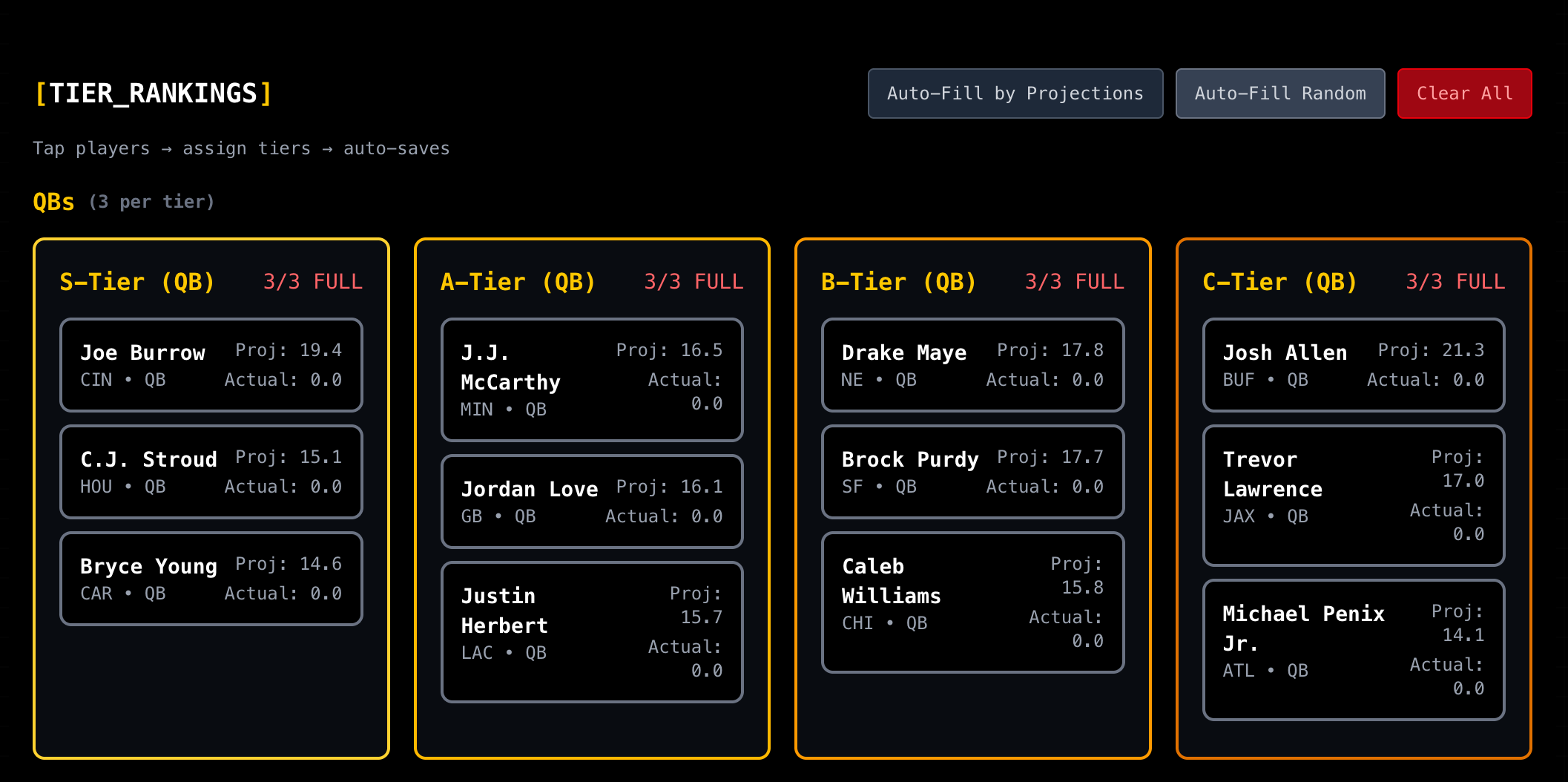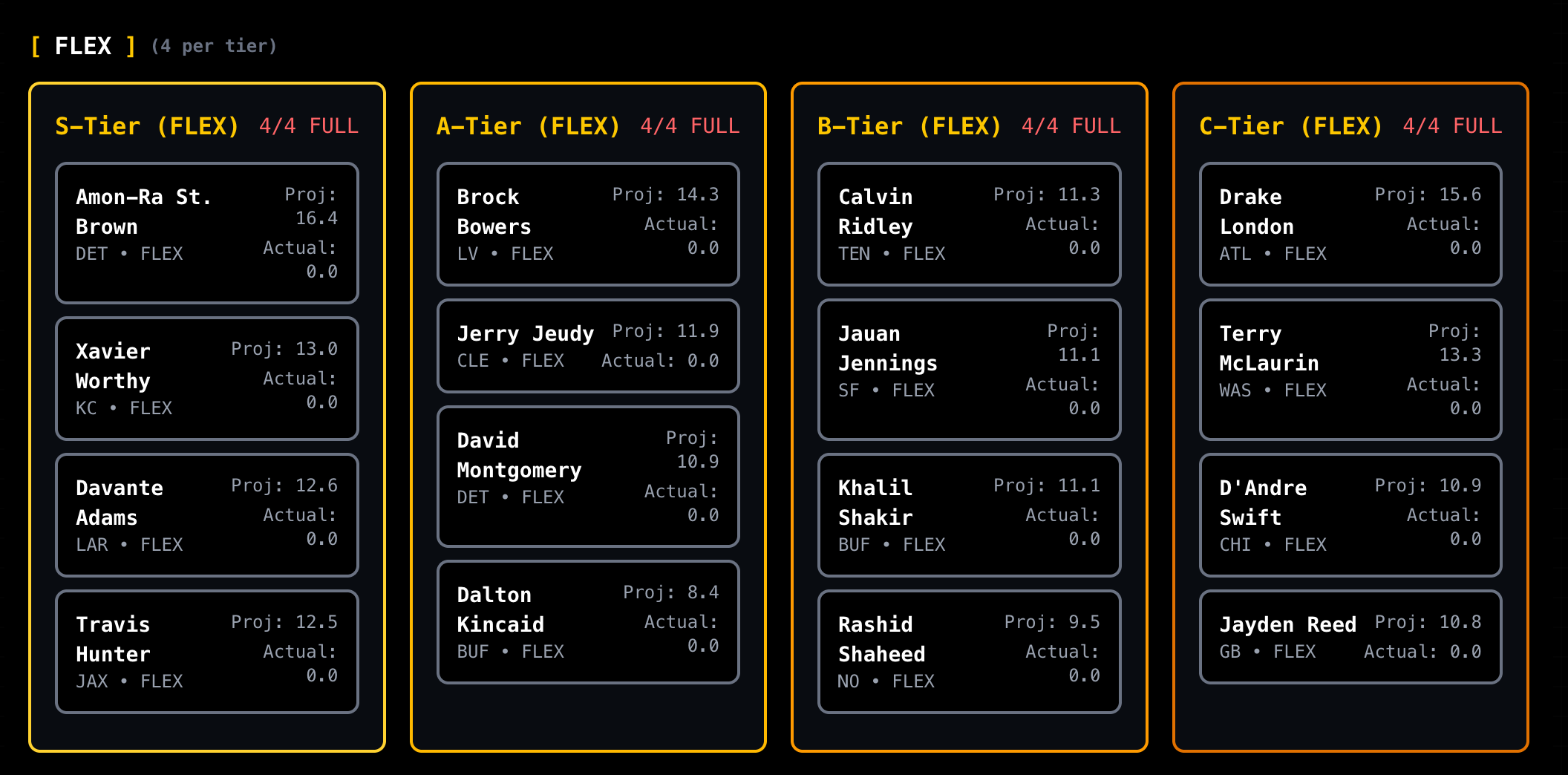TIER_UP: Master the Art of Fantasy Football Tier Prediction
Fantasy football has evolved beyond traditional lineup optimization. Welcome to TIER_UP—the cutting-edge prediction game that challenges you to forecast player performance tiers rather than exact point totals, creating a more strategic and skill-based competition.
This comprehensive guide reveals everything you need to know about TIER_UP, from basic gameplay mechanics to advanced tier assignment strategies that separate champions from casual players.
[What is TIER_UP?]
The Revolutionary Concept
TIER_UP transforms fantasy football from reactive lineup management into predictive player analysis. Instead of setting lineups after players are locked, you predict where QB and FLEX players will perform within structured performance tiers.
Core Gameplay:
- →Tier Assignment: Classify players into S/A/B/C performance tiers
- →Weekly Competitions: Compete against other players in time-limited contests
- →Skill-Based Scoring: Earn points based on prediction accuracy, not luck
- →Strategic Depth: Balance risk/reward across multiple tier assignments
Why Tier Prediction Matters
Traditional fantasy football often comes down to injury luck and waiver wire timing. TIER_UP rewards pure analytical skill by focusing on relative player performance prediction—a more sustainable competitive advantage.
[TIER_UP Scoring System]
Point Distribution
Exact Tier Match: 3 Points
- →Player performs exactly in your predicted tier
- →Maximum reward for perfect analysis
- →Separates expert predictors from casual players
Adjacent Tier (+/- 1): 1 Point
- →Player performs one tier above or below prediction
- →Rewards reasonable projections with minor miscalculations
- →Maintains competitive balance for close calls
Wrong Tier (2+ tiers off): 0 Points
- →Complete misread of player performance level
- →Penalty for poor analysis or overly aggressive predictions
- →Encourages thoughtful tier assignment strategy
Example Scoring Scenarios
Scenario 1: You predict Lamar Jackson in S-tier, he finishes S-tier → 3 Points
Scenario 2: You predict Josh Jacobs in A-tier, he finishes B-tier → 1 Point
Scenario 3: You predict DJ Moore in B-tier, he finishes S-tier → 0 Points
[Understanding the Tier System]
S-Tier (Elite Performance)
Characteristics:
- →Top 10% of weekly performances at position
- →Game-changing statistical output
- →Often includes 30+ point games for skill positions
- →Premium QB rushing performances (Lamar Jackson, Josh Allen type games)
Assignment Strategy: Reserve for players with elite matchups, guaranteed volume, and ceiling games.
 Example QB tier assignments showing elite rushing QBs in S-tier with high-volume pocket passers in A-tier
Example QB tier assignments showing elite rushing QBs in S-tier with high-volume pocket passers in A-tier
A-Tier (Above Average)
Characteristics:
- →Strong fantasy performances (15-25 points typically)
- →Solid floor with moderate ceiling
- →Consistent target share or rushing volume
- →Favorable game scripts and matchups
Assignment Strategy: Your "safe" high-end plays with good floor/ceiling balance.
B-Tier (Average Performance)
Characteristics:
- →Serviceable fantasy production (8-18 points range)
- →Role players with limited upside
- →Touchdown-dependent performances
- →Neutral matchups with moderate opportunity
Assignment Strategy: Conservative plays where you expect decent but not spectacular output.
C-Tier (Below Average)
Characteristics:
- →Poor fantasy performances (0-12 points)
- →Limited opportunity or difficult matchups
- →Injury concerns or reduced roles
- →Weather-impacted games or negative game scripts
Assignment Strategy: Players you expect to disappoint or face significant obstacles.
[Position-Specific TIER_UP Strategy]
Quarterback Tier Analysis
S-Tier Indicators:
- →Elite rushing upside (Lamar Jackson, Josh Allen, Jalen Hurts)
- →Premium passing matchups vs. weak secondaries
- →Dome games with high total expected points
- →Revenge games or primetime performances
A-Tier Profiles:
- →Pocket passers with high attempt projections
- →Good matchups without elite ceiling
- →Consistent QB1 performers in neutral spots
- →Game script advantage (expected trailing teams)
B-Tier Situations:
- →Average matchups with moderate passing volume
- →QBs with limited rushing upside
- →Potential weather impact or strong defenses
- →Backup QBs with unknown usage patterns
C-Tier Red Flags:
- →Elite pass defenses (top-5 DVOA)
- →Severe weather conditions (wind, rain, cold)
- →Injured or limited QBs with reduced mobility
- →Poor offensive line protection leading to pressure
FLEX Position Strategy
S-Tier FLEX Criteria:
- →RBs: 20+ touch projection with goal-line role
- →WRs: 8+ target floor with red zone opportunity
- →TEs: Premium target share in high-volume passing attacks
A-Tier FLEX Profiles:
- →RBs: Clear starter role with 15+ touches expected
- →WRs: #1 or strong #2 option with 6+ targets
- →TEs: Top-12 target share with touchdown upside
 Example FLEX tier assignments across RB/WR/TE positions showing volume-based tier placement
Example FLEX tier assignments across RB/WR/TE positions showing volume-based tier placement
B-Tier FLEX Considerations:
- →RBs: Committee situations with 10-15 touch range
- →WRs: Boom/bust profiles dependent on big plays
- →TEs: Moderate target share without elite ceiling
C-Tier FLEX Avoidance:
- →RBs: Limited role players or injured starters
- →WRs: Deep bench options with minimal opportunity
- →TEs: Blocking-focused tight ends with minimal targets
[Advanced TIER_UP Strategies]
1. Contrarian Tier Assignment
Theory: Identify spots where consensus tier expectations are wrong Application:
- →Assign players to unexpected tiers based on unique insights
- →Target overlooked game script advantages
- →Capitalize on injury/weather information gaps
Example: Assigning a typically B-tier player to A-tier due to key defensive injuries
2. Ceiling vs. Floor Balancing
High-Floor Strategy: Focus on A/B tier assignments with predictable outcomes High-Ceiling Strategy: Aggressive S-tier assignments accepting higher bust risk Balanced Approach: Mix safe predictions with calculated ceiling plays
3. Game Script Exploitation
Blowout Scenarios:
- →Winning teams: RBs move up tiers, WRs may drop
- →Losing teams: QBs and WRs gain tier value, RBs decrease
Close Games:
- →All skill positions maintain tier stability
- →Late-game usage patterns favor primary options
4. Weather and Venue Impact
Dome Advantages:
- →Passing games get tier boosts
- →Kickers and QBs benefit from controlled conditions
Outdoor Challenges:
- →Wind impacts passing tier assignments
- →Cold weather affects ball handling and kicking
[Weekly TIER_UP Process]
Tuesday: Initial Analysis
- →Injury Report Review: Identify opportunity changes
- →Matchup Analysis: Grade defensive weaknesses by position
- →Weather Monitoring: Check forecasts for outdoor games
- →Usage Trend Tracking: Analyze recent snap count and target patterns
Wednesday: Deep Dive Research
- →Advanced Metrics: Target quality, air yards, red zone looks
- →Coaching Tendencies: Situational playcalling patterns
- →Team Pace Analysis: Plays per game and neutral script volume
- →Vegas Line Movement: Identify shifting expectations
Thursday: Tier Assignment
- →Position Ranking: Order players within each tier
- →Risk Assessment: Balance ceiling plays with safe options
- →Contrarian Opportunities: Identify undervalued tier assignments
- →Final Submission: Lock in predictions before contests close
[Contest Strategy and Management]
Contest Selection
- →Entry Timing: Submit entries early to avoid last-minute locks
- →Contest Size: Larger fields reward contrarian plays more
- →Entry Limits: Manage bankroll across multiple contests
- →Skill Level: Target appropriate competition levels
Leaderboard Psychology
- →Early Weeks: Focus on consistency over home runs
- →Mid-Season: Balance safe plays with differentiation
- →Championship Rounds: Aggressive ceiling plays for tournament wins
Bankroll Management
- →Conservative Approach: 5-10% of bankroll per contest
- →Aggressive Approach: 15-25% for high-confidence weeks
- →Tournament Strategy: Larger allocations for championship events
[Common TIER_UP Mistakes]
1. Over-Tinkering Predictions
Problem: Changing tier assignments too frequently based on minor news Solution: Trust initial research and avoid reactionary moves
2. Ignoring Game Script
Problem: Assigning tiers without considering likely game flow Solution: Factor pace, total, and spread into all tier decisions
3. Recency Bias
Problem: Over-weighting last week's performance in tier assignment Solution: Focus on opportunity and matchup rather than recent results
4. Chalk Tier Assignments
Problem: Following obvious consensus tier expectations Solution: Identify spots for contrarian value while maintaining accuracy
[Advanced Analytics for TIER_UP]
Key Metrics to Track
Target Quality Analysis:
- →Air yards per target vs. league average
- →Red zone target percentage by player
- →Target depth distribution (short/intermediate/deep)
Usage Sustainability:
- →Snap count trends over 4-week periods
- →Touch efficiency for running backs
- →Route participation rates for receivers
Matchup Advantages:
- →Defensive DVOA by position and situation
- →Historical performance vs. similar offenses
- →Personnel package vulnerabilities
Predictive Modeling
- →Regression Analysis: Identify unsustainable hot/cold streaks
- →Usage Projections: Forecast opportunity based on game script
- →Efficiency Metrics: Target quality over quantity indicators
[Technology and Tools]
StatChat AI Integration
- →Real-Time Analysis: Live updates on tier assignment opportunities
- →Matchup Insights: Deep dive analytics on player/defense matchups
- →Historical Performance: Pattern recognition for similar situations
- →Optimization Engine: Balanced tier assignment recommendations
Data Sources
- →Advanced Stats: PFF grades, Next Gen Stats, Pro Football Focus
- →Injury Reports: Real-time updates and impact analysis
- →Weather Data: Comprehensive game condition forecasting
- →Line Movement: Vegas insights and market intelligence
[The Future of TIER_UP]
Evolving Competition
As TIER_UP grows, expect increased competition and more sophisticated analysis from participants. Success will require:
- →Deeper Research: More comprehensive preparation processes
- →Technology Adoption: AI-assisted analysis and prediction tools
- →Contrarian Thinking: Finding edges that others miss
- →Disciplined Process: Consistent methodology over emotional decisions
Platform Enhancements
- →Live Scoring: Real-time tier performance tracking during games
- →Advanced Metrics: Additional data points for tier assignment
- →Social Features: Community insights and collaborative analysis
- →Mobile Integration: Enhanced mobile prediction and tracking tools
[Getting Started with TIER_UP]
Step 1: Master the Basics
- →Understand the scoring system completely
- →Practice tier assignments for several weeks
- →Track prediction accuracy and identify patterns
- →Learn from both successes and failures
Step 2: Develop Your Process
- →Create a consistent weekly research routine
- →Identify reliable data sources and metrics
- →Build tier assignment decision trees
- →Establish bankroll and contest selection rules
Step 3: Advanced Strategy Implementation
- →Incorporate contrarian analysis opportunities
- →Develop game script prediction skills
- →Use technology tools for efficiency gains
- →Track performance and iterate on strategy
[Measuring TIER_UP Success]
Key Performance Indicators
- →Accuracy Rate: Percentage of exact tier predictions
- →Expected Value: Average points per prediction over time
- →Consistency: Standard deviation of weekly performance
- →ROI: Return on contest entry investments
Improvement Framework
- →Weekly Review: Analyze each prediction outcome
- →Pattern Recognition: Identify strengths and weaknesses
- →Strategy Refinement: Adjust approach based on results
- →Continuous Learning: Stay updated on evolving NFL trends
[Conclusion: The TIER_UP Advantage]
TIER_UP represents the evolution of fantasy football from luck-based outcomes to skill-driven competition. By mastering tier prediction, you gain sustainable competitive advantages that compound over time.
The key to TIER_UP success lies in consistent process, analytical rigor, and the courage to make contrarian predictions when your research supports them. While others guess at exact point totals, you're predicting performance ranges with higher accuracy and better risk management.
Ready to dominate TIER_UP competitions? Join StatChat's weekly contests and experience the most strategic fantasy football game ever created. Where traditional fantasy meets predictive analytics—and skill always wins.
Related Articles:
- →AI Waiver Wire Strategy - Build the perfect roster for TIER_UP success
- →Ultimate AI Fantasy Guide - Complete your fantasy football evolution with AI insights
- →Start/Sit AI Analysis - Master weekly decision-making with tier-based thinking
